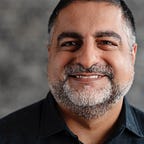My Secret Thoughts of America to Zanzibar at the Children’s Museum of Manhattan
[I was a paid consultant for the exhibit I discuss below, as the lead academic advisor. These views are my own, and do not represent any official position on the part of the museum or exhibit.]
For the last few years, I got paid to play with toys. I was able to put a philosophy of Star Trek’s Vulcans into practice, and live as a Jedi. Comics littered my work space, and Dr. Who’s TARDIS traveled with me through space and time. All I was missing was a Buffy or Firefly fix. All of this was possible because I was working on religious literacy and global citizenship.
I have a PhD in Islamic Studies from Harvard University. It’s not the profile that lends itself to perceptions of playfulness. But, five years ago, I started work with the Children’s Museum of Manhattan on an exhibit called America to Zanzibar: Muslim Cultures Near and Far.
The project started pulling on my expertise on Muslims and culture. As we got into the work, I realized that what we needed to do was center ourselves on unity through diversity. In the language of Mr. Spock, infinite diversity in infinite combinations.
This mantra seems to represent life in New York generally. It’s a big mess of people, learning to get along in millions of different ways. Leonard Nimoy, as the original Mr. Spock, also found a way to introduce his religious culture into the future culture of an alien race. His famous split-fingered hand gesture, coupled with the phrase “live long and prosper,” was based on the Hebrew letter “shin,” (ש) for “shekinah” (dwelling) or “shalom” (peace). 🖖🏽 A good-dwelling is a peaceful place.
The ways in which religion inflects our culture are numerous. It’s not about belief, but about beauty. The Jedi of Star Wars dress like Moroccan Sufis, or Muslim mystics. Like their real world counterparts, the Jedi are not interested in politics, but they are not divorced from the world. The focus is on becoming a better person and serving other people. We may be familiar with words like chemistry, algebra, or algorithm as coming from Arabic, and in part coming from the religious of impulse of Muslims to know the world to know God, but we do not think about this as religion influencing our culture. It is a search for a transcendent beauty.
I grew up on comics. For me, it was about the X-Men and the ways they represented people who were hated because they were different. That difference could be read as being about race, sexuality, or religion. The goal was to never be the same, but to recognize the difference and build on it. Sameness is boring. Diversity is a statement of fact, not an action. It’s how we get along, how we encourage pluralism, that creates a better, stronger, more inclusive society. Reading the character of Kamala Khan, the new Ms. Marvel, I can see how my comics have grown-up too. It is about new complexities, where differences are still very important, but not the cause of division.
The TARDIS, the great vehicle of Dr. Who, which is bigger on the inside, was an apt companion during this journey. In the design of the exhibit, we go from camels to immersive environments. We travel from America to Zanzibar. In just over 3000 sq. ft., we cover 1400 hundred years of history; 1/4 of the world’s population, and the entire globe. If the Vulcans give us infinite diversity in infinite combinations, then the Time Lords give us infinite possibilities for what our future could be. Also, the first director of Dr. Who was a British Muslim, Waris Hussein.
All of these bits of popular culture were instrumental in my thinking about the exhibit. At every instance, we see the ways in which religious references, Jewish, Christian, and Muslim, have become part of our American culture. We do not need to be religious, or subscribe to these religions, to appreciate the ways in which people who do identify with them create beautiful things.
That children get to experience beauty before difference is one of the great advantages that this exhibit has. They get to see the world as we should, noticing color, sound, touch, smell, and taste in terms of what is pleasing. They play to learn. They interact with other people to know who they are, and who they themselves are.
Working on this exhibit, I got to bring my academic expertise together with my geek self. There is a secret agenda I brought to this exhibit. It was for the possibilities that I saw around me as a kid, to be realized by another a generation of children.
PS — If you’re interested in religious literacy, check out a free course being offered at HarvardX. It features many of my colleagues and teachers.
If you know Joss Whedon, please pass this along. I really want him to come and visit the exhibit and cast me as his first Muslim character in his next production.
[Update 6 March 2021: Since this piece was published, it has become obvious that Joss Whedon was abusive on and off set. I do not wish to change the text of this article as it was published, but want to make clear that I do not condone, nor do I wish to be associated with, that behavior. I’ll skip working with Joss.]
